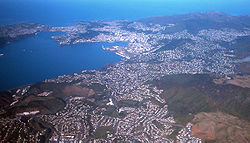Wellington City Council
|
Wellington
|
|
|
Wellington City (yellow) in the Wellington Region
|
|
| Population: | 207,900 (June 2016) |
| Land area: | 290.11 km² (112.01 sq mi) |
| Extent: | Extends north as far as Ohariu, Linden, Takapu Valley and Horokiwi. Bounded on the south and west by Cook Strait and the east by Wellington Harbour. |
| Mayor: | Justin Lester (since 2016) |
| Regional Council: | Wellington Regional Council |
Wellington City Council is a territorial authority in New Zealand, representing the country's third-largest city by population, behind Auckland and Christchurch. Wellington City consists of the central historic town and certain additional areas within the Wellington metropolitan area, extending as far north as Linden and covering rural areas such as Makara and Ohariu. The city adjoins Porirua in the north and Hutt City in the north-east.
Wellington attained city status in 1886. The settlement had become the colonial capital and seat of government by 1865, replacing Auckland. Parliament officially sat in Wellington for the first time on 26 July 1865. During the last half of the nineteenth century Wellington grew rapidly from 7,460 residents in 1867 to 49,344 by the end of the century.
The council represents a population of 207,900 (as of 2016[update]), and consists of a mayor and fourteen councillors elected from five wards (Northern, Onslow-Western, Lambton, Eastern, Southern). It administers public works, sanitation, land use and building consents, among other local services. The council has used the marketing slogan "Absolutely Positively Wellington" in an official capacity since the early 1990s.
The territorial authority is one of many councils in the greater Wellington area. Former mayor Celia Wade-Brown spoke against Wellington adopting a 'super city' type council like the one in Auckland, though is in favour of reducing the number of councils in the Wellington metropolitan area from nine to "three or four".
...
Wikipedia


